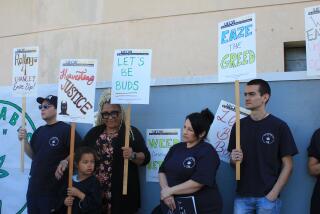Drivers beware: Risk of fatal car crashes spikes on the 4/20 marijuana ‘holiday,’ study says

Two physicians, John Staples and Donald Redelmeier, said 4/20 is “comparable in magnitude” to the increased risk seen on Super Bowl Sundays.
- Share via
Here’s a pro tip from a couple of doctors: Be sure to make special plans on April 20.
That date, of course, is the unofficial holiday devoted to celebrating all things marijuana. (You might know it better as “4/20.”)
The two physicians — John Staples of the University of British Columbia and Donald Redelmeier of the University of Toronto — aren’t asking that you honor marijuana’s medicinal properties by experiencing them directly. Rather, they’re warning you to be on alert for others who do — and then get behind the wheel while they’re still under the influence.
Data from the U.S. National Highway Traffic Safety Administration show that the risk of a fatal vehicle crash on American roads is 12% higher after 4:20 p.m. on an April 20 than on similar days that have no particular connection to pot, Staples and Redelmeier found.
That may not sound like much, but it’s “comparable in magnitude” to the increased risk seen on Super Bowl Sundays, when football fans gather to watch the game over beers, wine and cocktails — and then drive home, the pair wrote Monday in the journal JAMA Internal Medicine.
Staples and Redelmeier gathered 25 years’ worth of data collected in NHTSA’s Fatality Analysis Reporting System. They started with the year 1992 (the first full year after the magazine High Times turned 4/20 into a cultural phenomenon, the doctors said) and ended with 2016 (the most recent year with available data).
For all of the April 20ths combined, there were 1,369 drivers involved in fatal motor vehicle crashes that occurred between 4:20 p.m. — when the festivities generally get underway — and 11:59 p.m. (A crash was considered fatal if one or more people died within 30 days of the collision.)
That worked out to 7.1 crashes per hour.
The doctors compared those figures to the days one week before and one week after April 20, when marijuana use was presumably more typical but all other conditions were roughly the same. During the identical 7-hour-and-40-minute period on April 13ths and April 27ths, there were 2,453 drivers involved in fatal crashes.
That worked out to 6.4 fatal crashes per hour.
The difference was large enough to be statistically significant, the researchers found. In other words, it was too large to be due to chance.
The younger the driver, the bigger the increase in the risk of a fatal April 20 crash.
For instance, among drivers who were 20 or younger, there were 207 fatal crashes on all of the April 20ths; the average for the comparison days was 150. And for drivers ages 21 to 30, there were 353 fatal crashes on all of the April 20ths, compared with an average of 305 on the comparison days.
For all age groups combined, men got into nearly three times as many crashes as women. However, the increase in risk on April 20 was about the same for both sexes.
The researchers found that 4/20 has become deadlier over time. Compared with regular days, the number of fatal crashes on April 20ths was about 6% higher between 1992 and 2003. It jumped by about 17% between 2004 and 2016.
Over the entire study period, 4/20 celebrations were associated with an 8% increase in fatal crashes when they occurred on a “weekend” (that is, a Friday, Saturday or Sunday). When the holiday landed on a Monday through a Thursday, fatal crashes rose 15%.
All of these extra deaths occurred even though “the vast majority of Americans do not celebrate 4/20,” Staples and Redelmeier wrote. If its popularity continues to increase, so too may the number of traffic fatalities.
Legislators and voters should keep this in mind as they consider new laws that would make marijuana more freely available 365 days a year, Staples and Redelmeier warned. At the very least, the pair wrote, policymakers should consider “strategies to curtail drugged driving.”
Follow me on Twitter @LATkarenkaplan and “like” Los Angeles Times Science & Health on Facebook.
MORE IN SCIENCE
What do you see when you put miniature glasses on praying mantises? A new method for robot vision
Trifecta of opioids, alcohol and suicide are blamed for the drop in U.S. life expectancy







